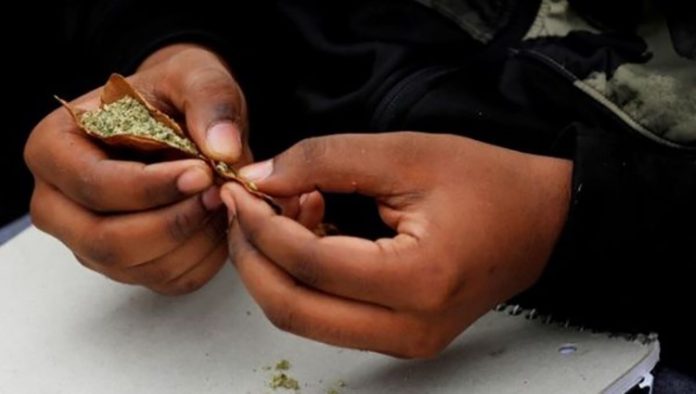Four years after New York City unveiled a new marijuana enforcement policy, lawmakers say data shows racial disparities persist in the marijuana arrest capital of the world—and blasted the NYPD for saying it’s due to complaints from communities of color.
In 2014, the city unveiled a new policy whereby officers issue a summons instead of carrying out an arrest if they find someone in possession of 25 grams or less of marijuana—as long as there is no warrant for the individual’s arrest and the individual has identification. Officers can make arrests if the marijuana is burning and if the type of possession shows intent to sell.
Roughly 86 percent of individuals arrested for marijuana possession in the fifth degree (possession of less than two ounces in a public place) last year were people of color. About 48 percent were black and 38 percent were Latino, while white people made up a mere nine percent. (In 2016, it was 80 percent, according to the Drug Policy Alliance).
At a joint hearing of the Council’s Public Safety and Justice Systems committees on Monday morning, Donovan Richards, chairman of the Public Safety Committee, outlined the number of marijuana arrests under previous mayors during their first three years in office.
Under the late former Mayor Ed Koch, there were 6,000 arrests; under former Mayor David Dinkins, 3,000; under Giuliani, 18,000; and under Bloomberg, 112,000.
In de Blasio’s first three years, he said, there were 61,000 arrests.
“To see 20,000 [a year] under an administration that has come in and said they’re going to correct the wrongs of the past, we find the numbers to be astounding,” Richards said.
He pointed to racial disparities in arrests in specific neighborhoods.
In Williamsburg, for example, black and Latino individuals make up 37 percent of the population but constitute 83 percent of marijuana arrests. And in Flushing, they make up 19 percent of the population and 83 percent of arrests.
“It doesn’t show that the department is really serious about addressing disparities in communities of color,” Richards continued. “Marijuana should not be a life sentence for anyone, and many of our young black and brown men and women are still being accosted… when other cities are looking to legalize marijuana at this point. It’s a disgrace and we have a long way to go to correct this.”
Dermot Shea, the NYPD’s chief of crime control strategies, said there has been a 40 percent decline in marijuana misdemeanor arrests since 2014 and that summonses were up 58 percent in 2017 compared to 2013.
The bulk of arrests, he explained, are occurring in 15 precincts in Harlem, Washington Heights, the South Bronx, Brooklyn and Astoria.
When Richards asked him whether he disagrees that there are racial disparities, Shea attributed the large number of arrests in those areas to 311 and 911 complaints.
“No, I would not disagree, and when you look at 2011, we have covered 65 percent of the arrests that we’ve made,” he said. “The remaining arrests that we make are… in parts of the city where we are receiving complaints from the public.”
He insisted that there is no disproportionate enforcement.
“I have no evidence to suggest that officers in white communities are enforcing the law any differently than they are in neighborhoods of color,” Shea continued.
The NYPD official said that in 2017, there were nearly 26,000 911 calls complaining about marijuana use—an increase of 12 percent from 2016. He also noted an increase in 311 calls.
Rory Lancman, chairman of the Justice Systems committee, said the NYPD has yet to submit the 311 data.
“We have emails to the department from the middle of February asking for this information because we know that this is how the department justifies this otherwise seemingly unjustifiable disparity,” Lancman said.
Shea contended it is hard to produce statistics on complaint calls because they include “marijuana spelled 15 different ways.”
Brooklyn Councilwoman Inez Barron wondered why the NYPD is undertaking implicit bias training if it does not see racial disparities.
“For you to say that you have no reason to believe that officers differentiate in their treatment of black, Latino communities and how they treat white communities is quite telling of how people in power don’t understand the systematic, embedded practices of racism that still exist in this country today,” Barron said.
Richards argued there is a “bigger question and a bigger systematic issue.”
“I refuse to believe that in New York City—a city of 8.5 million people—that the only individuals calling 911, 311 are people in communities of color,” he maintained.
The hearing comes amid a growing movement for marijuana legalization in New York City.
In his $168 billion fiscal year 2019 budget, Gov. Andrew Cuomo included funding for a study on the impacts of cannabis legalization, as well as on legalization in neighboring states. Mayor Bill de Blasio does not support legalization but is in favor of a study.
So far, Alaska, Vermont, Colorado, Oregon, California, Washington, Nevada, Maine, Massachusetts and Washington, D.C. have legalized adult-use marijuana. New Jersey Gov. Phil Murphy has also pledged to legalize recreational cannabis.














